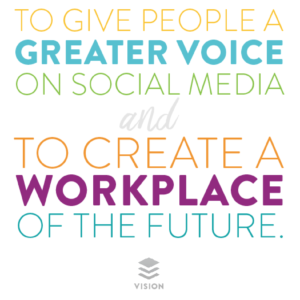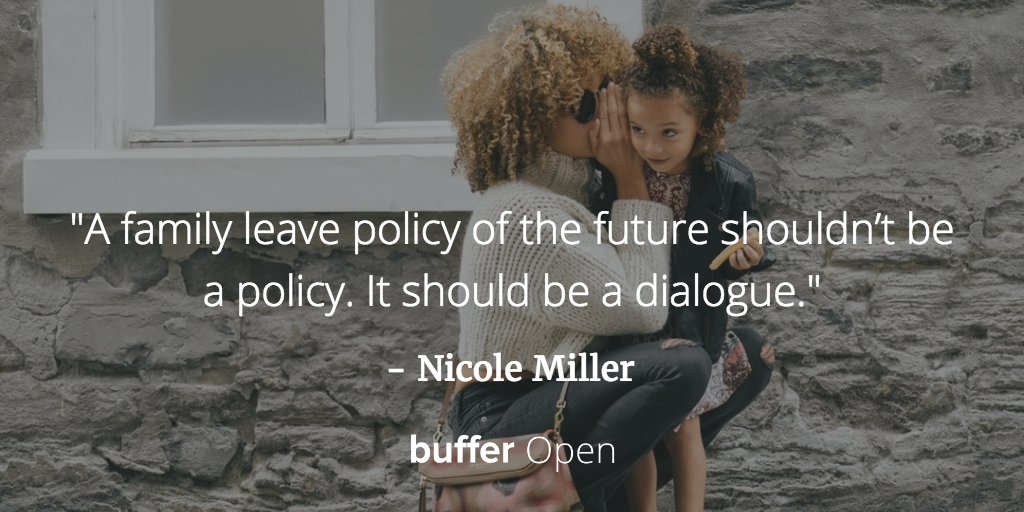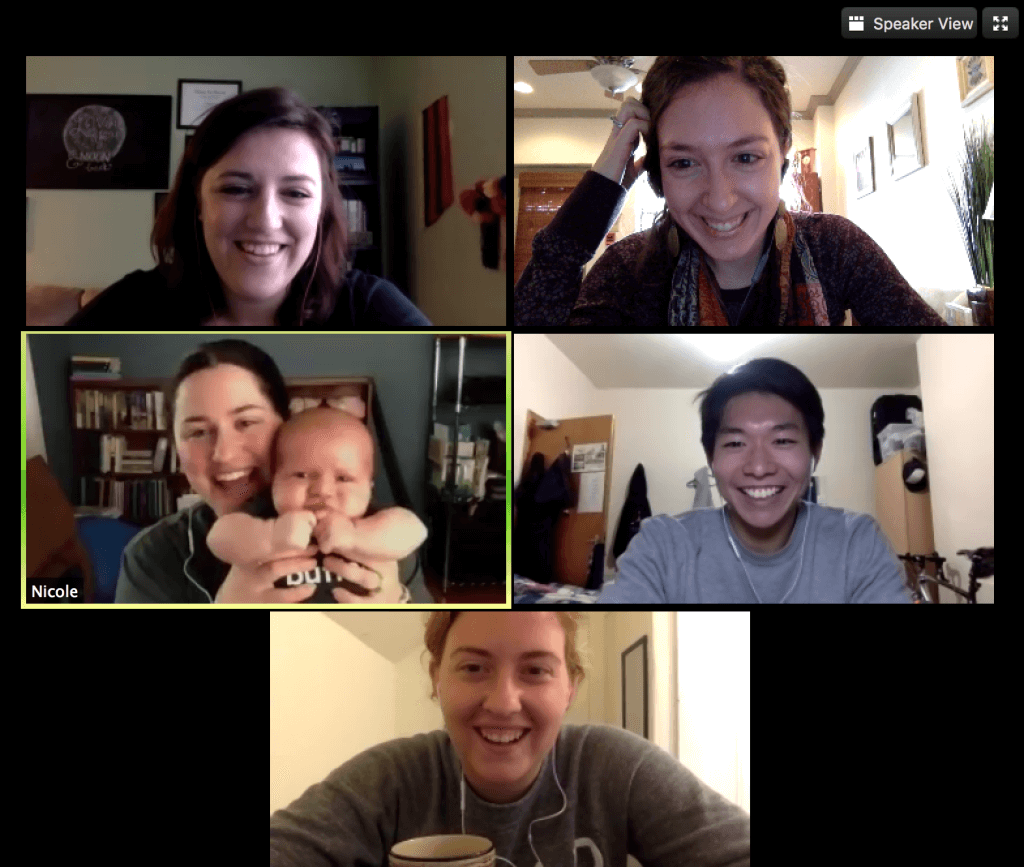What does a family leave policy look like for the workplace of the future?
What if your workplace is remote? And global?
What about leave types that aren’t related to having children: like bereavement leave, taking care of parents or aging loved ones… How do these fit into the workplace of the future?
These were some of the questions we considered as we dove deeper into our old (and fairly standard for most tech companies) family leave policy of 16 weeks paid time off.
Part of our company vision is “to create the workplace of the future,” and this left us with room to expand and elaborate on our policy.
What we wanted to change/be more clear about:
- We wanted to encourage parents to feel free to take more than the “minimum” time – so we adjusted our recommended range of time off.
- We wanted to be clear that all parents are treated the same at Buffer – regardless of gender or sexual identity.
- We wanted to assure team members that if their cultural or country norms erred toward a longer time (this is more common in European countries where leaves can range from six months and beyond) that we would work with them one-on-one and that their place in Buffer would be theirs whenever they return.
- We wanted to be clear that this benefit is available no matter how long a teammate has been on the team.
- We wanted to add in some ranges and notes about bereavement and care leave — before these were needed.
Here is what we compiled — it’s more of a “playbook” than a policy. Because as we’ve found with just the handful of folks who have taken parental leave at Buffer: there is no one-size-fits-all solution as there are no two families who are exactly alike! (My story is here! Some of our dads’ stories are here!)
We’d love to hear what you think about our playbook – feel free to share any thoughts in the comments!
What to Expect During Life’s Biggest Events At Buffer
(The TL;DR) Family Leave:
- All parents – regardless of gender or sexual identity – are treated equally at Buffer.
- We strongly urge a timeframe of 16 weeks of fully paid time off.
- Typical leave time can vary from country to country. If it feels best to take more than four months, we’d love to chat this over on a case-by-case basis and find a solution that works for the team and your family.
- We’ll be excited to welcome you back following your leave no matter how much time you spend away. Your place in Buffer will be waiting for you whenever it’s right to step back in fully.
Compassionate Leave:
- At Buffer, compassionate leave encompasses bereavement leave for loved ones lost and also time off to care for ill or aging family members.
- We encourage you to take at least 3–5 days off for bereavement leave (depending on your situation.)
- Care leave may take many forms and as this is a new area for Buffer, our recommendations are shaped by team member needs. Teammates are encouraged to talk with their team lead and the People team about their situation.
The full playbook
In the fall of 2016, Buffer set in place its vision and a playbook to help direct important decisions and guide the company.

Our vision to create a workplace of the future includes supporting our teammates and their families as well as our customers.
When it comes to families, no two situations are alike. What works for one family might not be best for another.
A family leave policy of the future shouldn’t be a policy. It should be a dialogue.

But if you’re looking for a glimpse at how we value families at Buffer, this is a good place to start.
What to Expect When You’re Expecting at Buffer
Where to start
When I found out I was pregnant with my first child, I had absolutely no idea what the first step would be. I’m not sure it gets any easier or clearer with the second, third or beyond. With adoption, surrogacy or foster care, this could be an even longer (or shorter!) process with many more unknowns.
For team members looking for a starting place when it comes to taking time away from Buffer to wholly focus on family, we’d love to encourage them to chat with the People team or team lead at any time. Teammates are also absolutely under no pressure to tell us anything until they feel ready!
We on the People team are happy to offer advice and serve as a liaison with team members and team leads before, during and after leaves. Whatever the circumstances, we’re here to support each other, 100 percent.
Who is eligible for paid leave?
Anyone at Buffer who is becoming a parent through childbirth, surrogacy, adoption or foster care is eligible for paid leave, no matter how long they’ve been on the team.
Having a child, adopting a child, fostering a child — these things can be unpredictable and we welcome them at any time.
All parents – regardless of gender or sexual identity – are treated equally at Buffer.
Buffer also provides an annual family stipend of $3,000 per dependent at the time of birth or adoption.
How much time is right?
Knowing how much time is right for you and your family is a tricky thing to plan for. Every family is different and we want to encourage each person to examine their own family needs and work team dynamics.
Sometimes a framework is helpful, and if that’s the case, we strongly urge a timeframe of 6–16 weeks of fully paid time off.
We’ll be excited to welcome teammates back following your leave no matter how much time they spend away. Your place in Buffer will be waiting for you whenever it’s right to step back in fully. As the nature of Buffer is to change and evolve quickly, we recognize that role might shift a bit over time, though any changes will be communicated in detail.
Part of this ongoing conversation with team members and the People team and their lead is to find the situation that works best for everyone.
Folks are welcome to split this family leave time over the first year of a child’s birth, adoption, or foster care. We’d love to discuss this on a case-by-case basis.
There are many factors that play into this: having a c-section generally means longer recovery time, if there are other children it might mean balancing more things, if adopting the process might require travel. Part of not having a “policy” is leaving a window of flexibility for these unknowns.
We strongly urge team members to plan on the longer side of the spectrum, with the option of returning early if they feel up to it. This way the team is prepared and tasks are covered.
Teammates never have to justify the amount of time they take or when they return. This experience looks different for every individual and every family. They’re welcome to share as much or as little as they’d like.
Considering your country norms
Typical leave time can vary from country to country. If it feels best to take more than three months, we’d love to chat this over on a case-by-case basis and find a solution that works for the team and your family.
Your time away
When to start? Before or after your new arrival? Babies (through birth, surrogacy, fostering, or adoption) come on their own time!
Medical or legal conditions outside our control can also factor in with the “unexpectedness” of the start of a leave, and doctor’s recommendations may also come into play.
We trust team members to know what is best for their family, and urge them to take the time as needed, whether that means you take a few weeks off before your due date or work right up until delivery.
Our advice: settle on as firm of a “return” date as possible so each team can plan around that. For the “start” date, we’ll be aware that this might be in flux and plan accordingly.
Easing back into work
Teammates are encouraged to return part-time (at full pay) for a short amount of time (from a week to a month – or more!) to ease back into work as part of the total leave time. These lengths of times can be customized for each family and we urge full communication of this with leads and teams.
Here are a few examples:
- I took 10 weeks fully off and then worked half-time on the 11th week of my leave. By the start of the 12th week, I was back to full-time hours and workload.
- Todd took two weeks off and then jumped into the Hawaii retreat after his son was born.
- Roy took a month off and jumped right back in full-time. (Here are some more examples too!)
- Caryn took six weeks fully off after the birth of her son and then eased back in with part-time work for several weeks.
We encourage our team to think outside the box and outside the 8 am to 5 pm schedule.
We are open to case-by-case discussions of extended leave or part-time hours at reduced pay.
This is a conversation we can have between each team’s lead and the People team either before or after the child’s birth or adoption.
If a team member need breaks during the day for baby care, breastfeeding or whatever is needed, one great way is to schedule them into your calendar (as best as you can ever “plan” around a baby!). Nicole or the People team can help discuss and set expectations with your manager and team.
Babies (and all kids!) in meetings

We want families to feel a part of the Buffer team and normalize this. Guest appearances from all children are welcome during syncs and meetings!
Teammates are encouraged to include their family in their life at Buffer as they see fit, sharing family pics or moments in Slack (we have a #culture-family channel!) or in our Facebook group, in Zoom meetings!
Rest assured:
- Children (or animals, for that matter!) are never an inconvenience. Don’t feel guilty if a moment or two is needed to tend to something!
- Kids’ noises are a welcome soundtrack to work and meetings and beyond. Again, no need to feel any guilt.
- We trust teammates to find the right balance with family and Buffer (this can be hard, and we’re keen to offer advice or any resources that might help.)
Retreats and other travel with young ones at Buffer
Our company retreats are in a constant state of evolution, and we’ll address caregiving and parents in the planning of each one.
For primary caregivers traveling to a Buffer retreat in the first year of a child’s birth, we’d love to assist in making this travel as seamless as possible. This might mean financial assistance to bring a caregiver with you or for additional childcare at home.
(This is our vision currently, though it is an ever-evolving policy!)
We’d love to chat about each of these on a case-by-case basis in relation to families with young ones who might need childcare assistance. We’ll also ensure that all breastfeeding moms have places to privately and cleanly pump or feed on all retreats.
Resources/great articles to check out:
Here at Buffer:
- Three dads on what family leave looks like at a remote company
- What family really looks like at a tech startup
- Tips for working from home with kids
- How I learned to balance life and family with remote work
- How we include family at Buffer
Across companies and across the world:
- It’s Not Okay Not to have a Parental Leave Policy – Cindy Alvarez
- Maternity Leave Policies Hurt Working Moms – New Republic
- 20 Companies with great Maternity Leave – The Workplace
- 29 Companies with the best Maternity Leave Benefits – WiseBread
- Paid Maternity Leave is Good for Business – by Susan Wojcicki – Wall Street Journal
- I’m sorry to all the mothers I used to work with – Fortune
- How should parental leave be structured? Ask Iceland – Slate
- New, unusual policy for working mothers – Washington Post
- How our small startup affords to offer paid maternity leave – FastCompany
- A Company that profits as it pampers workers – Washington Post
- A Patagonia VP explains a seemingly counterintuitive business decisions that helped the company triple its profits – Business Insider
- Twitter to give all new parents 20 weeks of paid leave – Fortune
- New York just passed the nation’s most radical paid leave family policy – Mashable
- San Francisco becomes first US city to mandate fully paid parental leave – The Guardian
- How the Tech Industry’s Women Problem is Advancing Paid Family Leave – Bloomberg
- Strong Families, Strong Business: A Step Forward in Parental Leave at Etsy – Etsy
- These are the companies with the best parental leave policies – Time
- 5 Facts that support gender-blind parental leave – Juliet Gorman on Medium
- Should you take leave before baby is born? – WSJ
- How long is the ideal maternity leave? – Slate
Supporting those coming back from leave:
- How companies can help your employees succeed after leave – Hired on LinkedIn
More resources!
Compassionate and Caregiver Leave at Buffer
Investing in our team means we’re here for the ups and the downs.
Though this is one type of leave we hope no one at Buffer ever needs to use, we hope to spell things out clearly so there is no question if and when the time comes.
At Buffer, compassionate leave encompasses bereavement leave for loved ones lost and also time off to care for ill or aging family members.
Bereavement Leave
We encourage you to take at least 3–5 days off for bereavement leave (depending on the situation.) There is no maximum recommendation for this sort of leave; we encourage team members to take the time you need.
According to Russell Friedman, author of The Grief Recovery Handbook, “Workers need at least a week to deal with all the logistics surrounding a death and burial, especially given many of us don’t live near our loved ones these days. Not to mention that people need time to grieve the loss because they won’t be as productive right after the death of someone close.”
We don’t want our team to feel any guilt or pressure to return back to work during these tumultuous times. Family comes first.
“You can’t park your grief at the office door and then pick it up at five. When your heart is broken your head doesn’t work right.” – Friedman
Caregiver Leave for Family and Loved Ones
- An estimated 44.4 million Americans provide unpaid care to an adult family member or friend in the U.S.
- Nearly six in 10 of these “informal” caregivers (59%) juggle work with caregiving responsibilities in order to meet both their own financial obligations and the costs of caring for a seriously ill relative or friend.
- Furthermore, an estimated 40 percent of workers provide help to their elderly parents during periods of serious illness or disability.
- 139 countries provide paid leave for short- or long-term illnesses (U.S. not included), with 117 countries providing a week or more annually.
Care leave may take many forms, including eldercare and aid for other sick family members or partners. Since this is a new area for us at Buffer, our recommendations are still being formed and will be driven by our team’s needs.
Teammates are encouraged to talk with their team lead and the People team about their needs for remote work, flexible time, disability leave, eldercare leave and/or other support.
Most importantly, we’re confident to assure of two things:
- Most or all of the needed leave will be paid. (This will be discussed on a case-by-case basis.)
- Team member’s places in Buffer will be protected and guaranteed upon return.
This can take many forms, including long-term care or short-term. When my mom had surgery on her ankle, I worked from her house for several days to help her out, and let my team know that I might not be fully available those days.
Resources:
- 5 Flexible Work Strategies – and The Companies Thriving With Them
- Sample Bereavement Leave Policy
- Worker’s Bereavement Leave Often Falls Short
- Should Everybody Get Paid Bereavement Leave? BBC
- Support for Working Family Caregivers: Paid Leave in California and Beyond
- Protecting Family Caregivers from Employment Discrimination
- Deloitte Just Gave Its Workers 16 Weeks Paid Leave for Caregiving
- Advances in Workplace Protections for Family Caregivers
Room for flexibility
The beauty of life is that no one can plan for everything.
If something — anything — comes up where teammates feel that some time off or an adjusted schedule might be best for their health, happiness and productivity, we encourage a chat about this with team leads or the People team.
This is how we create and shape a workplace of the future.
Coming soon to supplement our playbook: “The Manager’s Guide to Family Leave”
One feeling we’ve heard from several of our managers on the team is a desire to know how to support their team members before, during and after their family leave.
We’re working on an addendum to this playbook for our leads that share a bit about what to expect when your teammate is expecting — especially as it applies to a remote team!
Keep an eye out for this soon — we’re excited to share the resource!
Over to you
There it is!
We’d love to hear your thoughts on this as it is an ever-evolving document and mindset for us at Buffer. What did we leave out? What stood out to you? Do you have any positive or negative experiences with a family or compassionate leave that you learned from?
We’d love to hear from you in the comments!
Try Buffer for free
190,000+ creators, small businesses, and marketers use Buffer to grow their audiences every month.




